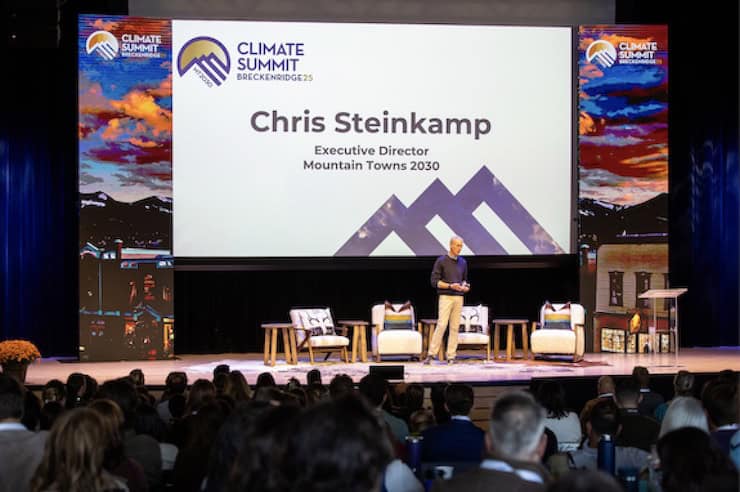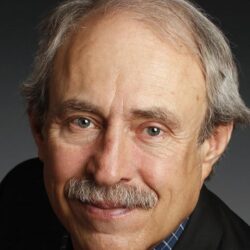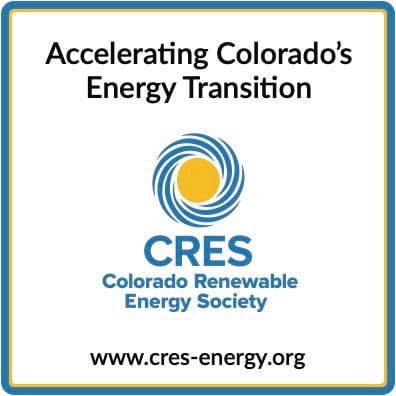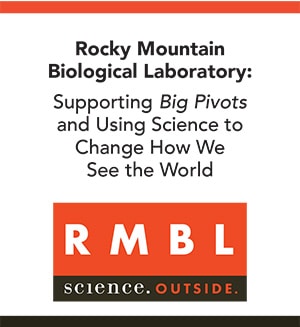Bill McKibben headlined this year’s summit in Breckenridge. But the diversity of other speakers testifies to the momentum this organization has.
by Allen Best
Mountain Towns 2030 has wheels. It has legs. The evidence of its momentum was ample at the annual conference held Oct. 6-8 in Breckenridge.
More than 600 people attended. More impressive was the lineup of speakers. Mark Jacobsen had come from Stanford University to speak. You can’t wander very far down the energy transition rabbit hole without coming across his work and proclamations.
Electrical utilities took it seriously enough to send representatives, not just some guy or gal in a cubicle at the end of the hallway. Duane Highley, the CEO of Tri-State Generation and Transmission Association, had driven up from the Front Range for a panel about 100% renewables energy. Bryan Hannegan from Holy Cross Energy was on the same panel, and so was Chris Hansen. Hansen was a sponsor of many of the key pieces of legislation from 2019 through 2024 that framed Colorado’s transition. Xcel Energy was represented by Andrew Holder, the company’s director of community relations and local governmental affairs. The panel was moderated by Jon Creyts, the CEO of RMI, formerly known as the Rocky Mountain Institute.
Bill McKibben was this year’s headliner. He has a new book, “Here Comes the Sun.” He reported that he had been in 37 hotel rooms in the previous 40 nights. One of those hotel rooms, presumably, had been occasioned by his visit to the pope’s summer house, which is 45 minutes outside Rome. “It turns out to be on top of a 600-year-old castle on top of a beautiful hill with a stunning view of the Mediterranean,” he said.
Two weeks before, McKibben had been in Colorado to speak at two venues and perhaps more, one just down the street from me, unbeknownst to me until afterward. After his talk in Breckenridge, he was off to Crested Butte. The guy keeps busy. This was the sixth time I have seen him in Colorado during the last 20 years: first in Telluride, later in Boulder, and three times in Denver. Mostly he plays to full houses. One of his Denver visits was to promote a book. Fewer than 30 were at the Tattered Cover event. Highs and lows.
McKibben is on a high now. Copies of his book were available to all who attended the event at Breckenridge’s Riverwalk Center. Nearly all seats were filled, and at least one director of a prominent Colorado state agency was in attendance.
“I live in a mountain town myself,” McKibben said. “Not this high up, but high enough that it has both a downhill ski area and a beautiful Nordic track. I know that most of you come from the gravity-driven section of the skiing world, where you’re willing to let Issac Newton do most of the work. But I hope there are a few other devoted Nordic skiers.”
His remarks during the next 30 minutes were a synopsis of his book, which Big Pivots plans to formally review soon. It’s so current that some of his writing was done in May. It’s hard to write a book about the energy transition when so much is happening so quickly.
And there is distinctly good news to write about, as he shared in both his remarks in Breckenridge and in his book. The economics and superior technology of renewables have become unassailable. Of course, the Trump administration sees the world differently.
The flip side is that it’s getting very, very close to deadline. Already, the responses of the climate to mountain greenhouse gases have become greater than what was predicted. The margin for error has narrowed.
“Climate change is a damaged relationship with the sun,” he said. “So, as with many damaged relationships, the way to repair it is not to avoid that relationship, nor in this case, I think, to fill the sky with sulfur in an effort to blot more of the sun. The way to repair it is to deepen that relationship, to turn to the sun.”
McKibben is clearly at ease at the lectern. At times, he stood with his hands behind is head, as if relaxing at a baseball game. He most certainly would lose points for that at a Toastmasters event. On the other hand, he’s good enough to make up his own rules.

Park City’s Luke Cartin, second from right in the front row, was a driving force behind creation of Mountain Towns 2030. Photos on this page/Jos Kusumoto Photograph
Also notable was Ramón Méndez Galain, the secretary of energy in Uruguay from 2007 to 2015. Uruguay had been an energy importer, placing a grievous burden on its economy. It set out to switch to renewables and has greatly succeeded. Now, 98% of the electricity comes from renewables and 65% of the country’s energy overall, he reported. And the country is now thriving. A very big pivot, if you will.
At the hotel that evening, I happened to walk down the hallway the same time as Ian Billick, the mayor of Crested Butte. I think I had last seen him in the flesh 15 years ago, when he was testifying before an interim legislative committee at the Colorado Capitol. We talked a couple of times at length during our shared time in Breckenridge, and they were rewarding conversations.
I also talked informally with a state employee without the need to have a public information officer present. What a nice 15- to 20-minute conversation that was. I remember 10 years ago writing a story about Colorado River water and going to a conference in Santa Fe where a member of the Metropolitan Water District of Southern California — the wholesale water supply organization for 26 million people — spoke about water conservation. We talked afterward in the hallway, and what he was able to tell me was very valuable to the story. He said if I had tried to talk with him when he was back in the office, it would have to go through a PIO and he would have been able to say much less.
So that is part of the story of Mountain Towns 2030: a rubbing of elbows and a sharing of notes. And that, incidentally, is something that I tried to do from 2002 to 2019 in a vehicle called Mountain Town News. Early on I had gained an interest in climate change. Immediately after getting myself grounded in the science, I turned to the energy transition. Some of this I shared with my readers in Big Pivots, but I didn’t think I could go too deep.
The irony is that Mountain Towns 2030 came along just as I dropped Mountain Town News in favor of Big Pivots. But the organization of Mountain Towns 2030 has wheels, as I said at the outset. It has succeeded in connecting people in ways that work for those people.
Afterward, I sent questions to Chris Steinkamp, the Boulder-based director of Mountain Towns 2030.
1) At your annual conference held this year in Breckenridge in early October, you had more than 600 registrants.
The majority of attendees came from Colorado and the Intermountain West, but we also welcomed participants from California, Washington, West Virginia, Vermont, Massachusetts, and more.
The Summit has grown steadily from about 250 attendees in 2019 to over 600 this year. Represented were 61 mountain communities and 37 ski resorts.
Our reach continues to grow, due not only to positive word of mouth but also to strong alliances with the National Ski Areas Association, Ski Area Management magazine and corporate partners Alterra Mountain Company, Vail Resorts, Boyne Resorts, and POWDR. These partners see these Summits as a unique opportunity to engage local resorts in the broader climate conversation while strengthening connections with their local communities.
Alaska Airlines also sponsored a scholarship program that brought community leaders to the Summit from California and Washington. These partnerships have been instrumental in growing both the size and impact of the summit.
2) What is the origin story for Mountain Towns 2030? How did it come together?
MT2030 was founded in 2019 in Park City, led by Mayor Andy Beerman, Ski Butlers founder Bryn Carey, local climate activist Eyee Hsu, and Luke Cartin, the sustainability manager for Park City Municipal.
Park City had just established a citywide goal of net-zero emissions of greenhouse gases by 2030, but they realized that real impact would only come if other mountain towns could do the same. By leveraging all the data and insights that Park City had, they could help other communities move quicker, driving systems-level change.
3) Why mountain towns? Why not Front Range cities, for example. Or some other unifying theme?
Mountain communities are truly on the front lines of climate change. With devastating wildfires, warmer and wetter winters, droughts happening all year — climate is a material threat to the future of our communities, our local economies, and our way of life. There is so much at stake. Every mountain community, regardless of location, is feeling the same pressure and generally deploying the same solutions. It’s a shared threat amongst us and a powerful unifying force.
4) What kind of cross-over is there between the ski industry and Mountain Towns 2030?
You can’t have a conversation about climate change in a ski town without the resort being involved. We’re focused on bringing all the key community stakeholders together (elected officials, municipal sustainability teams, resorts, local businesses and nonprofits) to share ideas, best practices, data and resources and without a doubt, the ski industry is critical part of that.

Chris Steinkamp says underwriting of Mountain Towns 2030 has not been a hard sell.
5) Mountain ski-based resort towns tend to be at the front edge of innovation — and sometimes problems, too. On the flip side, they tend to be risk takers. I was in Vail in the mid-1990s when Vail rolled the dice on what was called the first modern roundabout as a solution to its perplexing traffic situation at what was then called the four-way stop. I saw 45-minute waits during Christmas week. There were many prophecies of great disaster. Instead, it was an instant success. This roundabout was the first of its type in Colorado. Soon, they were omnipresent in Colorado and beyond. People visited Vail and saw how well that roundabout worked. Are there areas where you are seeing innovation in ski towns in response to the climate challenge?
A great example is the deployment of thermal energy networks. Several mountain communities are innovating with new system designs, financing and business models, and proving that this zero-carbon technology can succeed in various unique environments. The shared data and lessons from these projects are helping accelerate adoption in other towns and larger urban areas.
We know what to do. The solutions we need are not only available but proven. It’s just a matter of how quickly can we get it done?
6) How much overlap is there between Mountain Towns 2030 and the Colorado Association of Ski Towns — which also has membership from ski towns in Wyoming, Utah and Idaho?
Quite a bit. CAST has been a close partner of ours since MT2030’s launch in 2019. Elected officials are a critical part of our work. Many CAST members see great value in the conversations happening at the MT2030 Summit and I think we’ve introduced some new communities to the valuable CAST network. Therefore, we’ve made it a priority to coordinate closely with CAST so that our events are held consecutively, in the same venue, allowing mayors and other leaders to travel once for both gatherings. It’s worked well for both organizations.
7) Tell us about the underwriting and sponsorships of your conferences? Has that been a hard sell?
It’s not a hard sell. If it was, I’m not sure they’d be the right partner for us. Given this alignment, we work hard to make sure that corporate partners are an integral part of the Summit vs being just “sponsors.”

Several dozens sessions were devoted to everything form mitigatoin of metahen form the coal mines near Carbondale to the geothermal.
8) Is there an advocacy role for your organization in the state or federal levels?
Yes, absolutely. Elected officials and ski resort leaders have immense influence; with real, economic accounts of how climate change is impacting their communities and businesses. As constituents, they’re the best lobbyists, and the economic message they’re delivering is powerful for lawmakers to hear, from both sides of the aisle. Their unified voices have been missing in DC so we’re planning a lobby trip in spring 2026 to take these stories to Capitol Hill.
9) Again, I wonder about results. Are there other examples of collaboration and progress resulting from Mountain Towns 2030?
Yes, many. The Summit is designed to make those actionable, personal connections. For example, we have a ton of casual networking time built into the agenda, and work sessions are led by community peers so that the content is presented in a context that’s highly relevant and actionable with a personal connection for future conversations. If we can just share the successes from peer communities and enable those personal connections, good things happen.
Leaving the 2019 Summit, leaders from the Town of Breckenridge decided to push forward with an ambitious net-zero climate action and new housing development plan. A town council member who hadn’t previously prioritized climate action attended last week’s Summit and returned to her council meeting inspired, saying they all need to do more. Eagle, Colo., passed a net-zero resolution after the 2022 Summit, followed by Jackson, Wyo., Ridgway, Colo., and several others. We have dozens of anecdotal success stories that came from the content and personal connections made at the Summit.
10) Two years ago, at your conference in Vail, you had Jane Goodall. This year you had Bill McKibben speak — along with some other names that are nationally known, at least to those of us deeply engaged in the energy transition. What does it take to persuade speakers to travel to some mountain town in the West?
We always aim to bring in speakers who not only inspire but also deliver valuable, actionable insights to our audience. Having Bill McKibben join us in Breckenridge this year accomplished both.
Sure, coming to a beautiful mountain community in the fall is an easier sell than coming to an airport hotel conference, but the speakers we seek out are genuinely invested in this mission.
Also, the Summit has also earned a reputation as a well-run event and very different than a typical conference. Our attention to detail is a big reason our attendees return year after year and why so many speakers choose to come and stay for the week, to be part of the full experience.
11) Any tweaks for Mountain Towns 2030 that you might want to share?
We’re turning our focus to building out year-round programming. There’s tremendous value in bringing mountain community leaders together more than just once a year, so we’re planning a series of one-day regional events to foster ongoing collaboration and momentum. We’re also already gearing up for the 2026 Summit in Sun Valley, Idaho.
- After a misstep about nuclear, DIA now looking at all energy options - November 13, 2025
- A possible victory for moderate solar regs - November 10, 2025
- Should this have instead been called the Data Center Solicitation? - November 7, 2025






